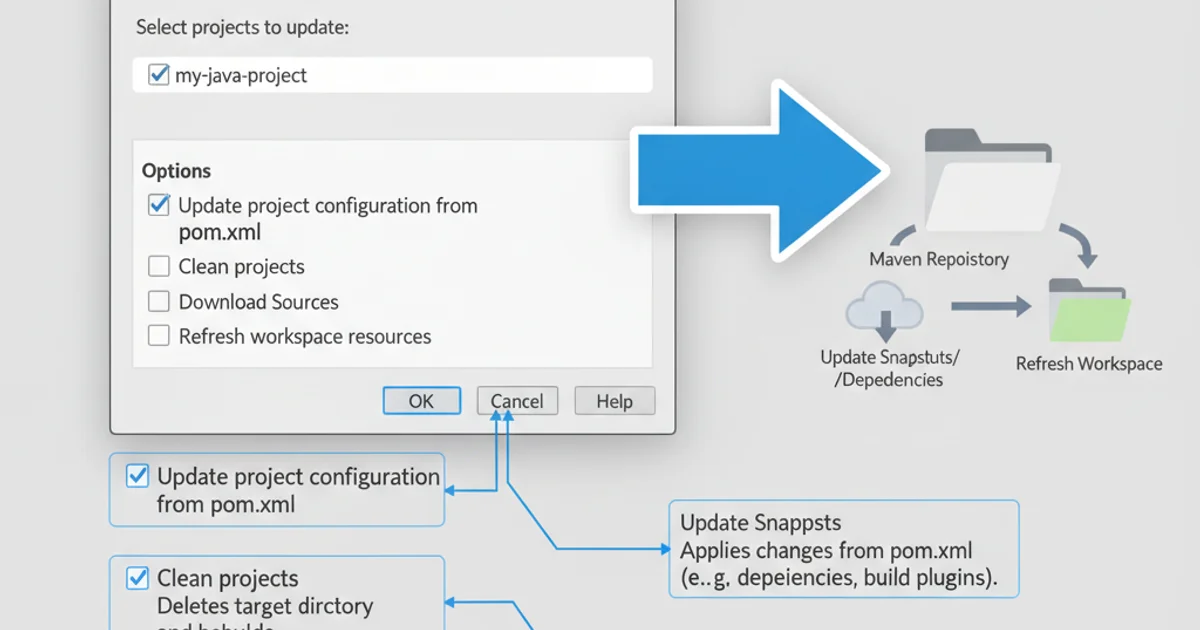What does Maven Update Project do in Eclipse?
Categories:
Understanding Maven Update Project in Eclipse

Explore what 'Maven Update Project' does in Eclipse, why it's crucial for project synchronization, and how it resolves common development issues.
When working with Maven projects in Eclipse, you'll frequently encounter the 'Maven Update Project' option. This seemingly simple action is fundamental to keeping your Eclipse workspace synchronized with your project's Maven configuration. Without it, changes to your pom.xml or underlying dependencies might not be reflected in your IDE, leading to compilation errors, missing libraries, or incorrect project structures.
What Does Maven Update Project Do?
The 'Maven Update Project' (often abbreviated as MUP) command in Eclipse, typically accessed via Right-click on project -> Maven -> Update Project..., performs several critical tasks to ensure your Eclipse project accurately reflects its Maven definition. It essentially re-reads your pom.xml and reconfigures the Eclipse project settings based on that information.
flowchart TD
A[Start: User initiates 'Maven Update Project'] --> B{Read pom.xml}
B --> C[Resolve Dependencies]
C --> D[Update Project Classpath]
D --> E[Update Project Facets/Natures]
E --> F[Generate Eclipse-specific files (.project, .classpath)]
F --> G[Refresh Workspace]
G --> H[End: Eclipse project synchronized with Maven]Flowchart of the Maven Update Project process
Specifically, MUP handles the following:
1. Dependency Resolution
It re-downloads or verifies all declared dependencies in your pom.xml (including transitive ones) and adds them to the Eclipse project's classpath. This is crucial when you add new dependencies, change versions, or when a dependency's artifact is updated in your local or remote Maven repository.
2. Plugin Configuration
It processes Maven plugin configurations defined in your pom.xml. Many plugins (e.g., maven-compiler-plugin, maven-war-plugin) have specific Eclipse integration points that MUP uses to configure project builders, source folders, and output directories.
3. Source and Resource Folders
It ensures that your project's source folders (e.g., src/main/java, src/test/java) and resource folders (e.g., src/main/resources) are correctly configured in Eclipse, allowing the IDE to properly compile and manage your code and assets.
4. Project Natures and Facets
It updates Eclipse project natures (e.g., Java Project, Maven Project) and facets (e.g., Dynamic Web Module, JPA) based on the packaging type and plugins defined in your pom.xml. This is vital for web projects or projects using specific frameworks.
5. Build Path Updates
It rebuilds the Eclipse project's build path, ensuring all necessary JARs, source folders, and output locations are correctly referenced for compilation and execution within the IDE.
When and Why to Use It
You should perform a 'Maven Update Project' whenever your pom.xml changes or when you encounter unexpected build or runtime issues that might stem from an out-of-sync Eclipse configuration. Here are common scenarios:
pom.xml or after switching branches.Common triggers for MUP:
1. Adding/Removing Dependencies
After modifying the <dependencies> section of your pom.xml, MUP will fetch new JARs or remove old ones from the project's classpath.
2. Changing Dependency Versions
If you update a dependency's version, MUP ensures the correct version is used by Eclipse.
3. Modifying Plugin Configurations
Changes to <build> section, especially plugin configurations, require MUP to apply them to the Eclipse build process.
4. Switching Maven Profiles
If your project uses Maven profiles that alter dependencies or build configurations, MUP will apply the profile-specific changes.
5. Resolving 'Project configuration is not up-to-date' warnings
Eclipse often detects when the pom.xml has changed and will prompt you to update the project. Always heed these warnings.
6. After a git pull or branch switch
If your pom.xml might have changed due to version control operations, MUP is a safe first step to re-synchronize.
Advanced Options and Best Practices
When you open the 'Maven Update Project' dialog, you'll see a few options. Understanding them can help you troubleshoot more effectively.

The Maven Update Project dialog showing available options.
The most common options are:
1. Update Snapshots
If checked, Eclipse will attempt to resolve and download the latest SNAPSHOT versions of dependencies from your configured Maven repositories. This is useful during active development of interdependent projects but can slow down the update process.
2. Force Update of Snapshots/Releases
This option forces Maven to check remote repositories for newer versions of both SNAPSHOTs and release artifacts, even if they are already present in your local repository. Use this when you suspect your local repository might be stale or corrupted, or when a release dependency has been updated in a remote repository without a version change (though this is generally discouraged in Maven).
In summary, 'Maven Update Project' is an indispensable tool for any developer working with Maven in Eclipse. It bridges the gap between your project's declarative Maven configuration and Eclipse's internal project model, ensuring a consistent and error-free development environment.